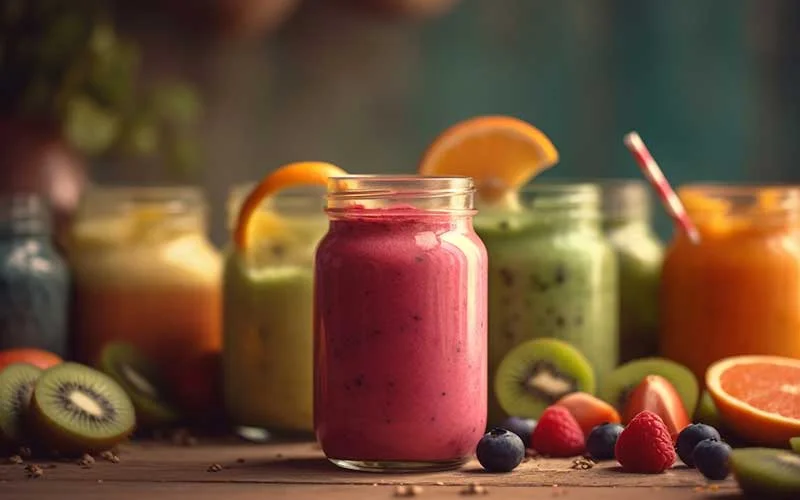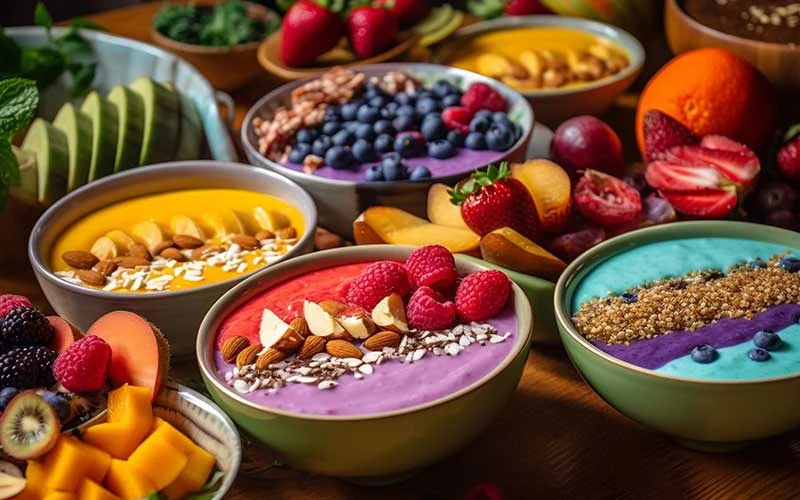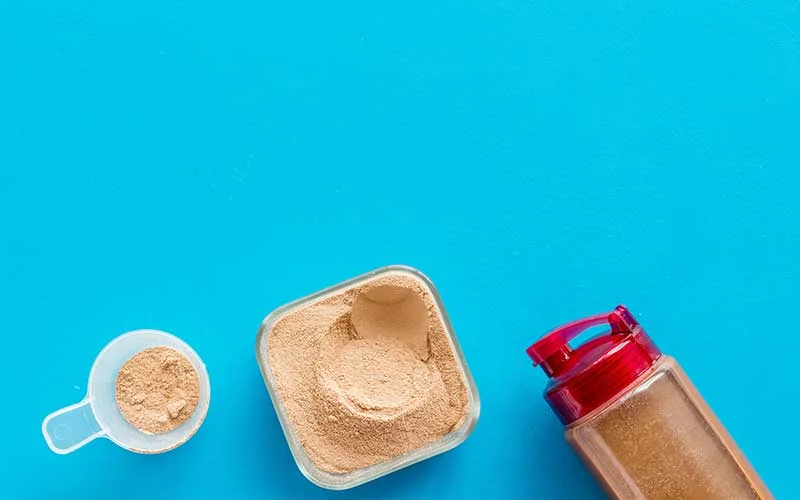Are you trying to decide between smoothie bowls vs shakes? When it comes to picking what to eat in our busy lives, we often have a choice between smoothie bowls and shakes. These are popular options that taste good and give our bodies the right nutrients. In this guide, we’ll take a closer look at healthy smoothie bowls and shakes, the difference between a smoothie and shake, and find out why they’re good for us. By the end, you’ll know which one is better for you and your diet. First, lets discuss what are smoothie bowls and shakes.
What Are Smoothie Bowls?
Smoothie bowls are a refreshing twist on the classic smoothie. Instead of sipping your blended concoction through a straw, you spoon it from a bowl. Typically, a smoothie bowl consists of a thick and creamy base made by blending fruits, vegetables, and liquid (such as yogurt or milk). This base is then topped with an array of toppings, ranging from fresh fruits and nuts to granola and seeds. The result is not only visually appealing but also a delightful mix of flavors and textures.
What Are Shakes?
Shakes, on the other hand, are beverages made by blending ingredients like milk, yogurt, fruits, vegetables, and even protein powders into a smooth, liquid form. Unlike smoothie bowls, shakes are meant to be sipped, making them a quick and convenient choice for those on the go. They come in various flavors and can be customized to suit your taste preferences and nutritional goals.
What is the Difference Between Smoothie and Shake?

At first glance, smoothie bowls and shakes might seem quite similar since they both involve blending ingredients. However, there are some key differences that set them apart:
| Aspect | Smoothie | Shake |
| Consistency | Thick, spoonable | Liquid, sippable |
| Presentation | Served in a bowl | Served in a glass or cup |
| Toppings | Loaded with fruits, nuts, seeds, granola | Typically consumed as-is, no additional toppings |
| Eating Experience | Savored slowly with a spoon | Consumed quickly by sipping |
| Calories and Macronutrients | Varies (around 300-500 calories); Rich in carbs from fruits, protein from yogurt/milk, fats from toppings | Varies (around 300-700+ calories); Protein-rich; Carbs and fats vary |
| Fiber Content | High due to whole fruits, veggies, toppings; Promotes fullness and digestion | Lower fiber content; Some from ingredients like spinach |
| Sugar Levels | Variable; Natural sugars from fruits; May be high with added sweeteners | Variable; Some low in sugar, others high with added sugars |
| Micronutrients and Antioxidants | Rich in vitamins, minerals, antioxidants; Toppings add healthy fats | Nutrient content varies; Protein shakes contain amino acids |
Health Benefits of Smoothie Bowls

Smoothie bowls are like a colorful nutrition bomb. But, is smoothie bowl healthy? Well, they’re filled with healthy nutrients that can help your body in different ways. Here’s some smoothie bowl nutrition facts about them:
Nutritional Benefits
Vitamins and Minerals: Healthy smoothie bowls are rich in vitamins such as vitamin C, vitamin A, and vitamin K, as well as minerals like potassium and magnesium.
Antioxidants: The abundance of fruits in healthy smoothie bowls provides a powerful dose of antioxidants that help combat free radicals in the body, potentially reducing the risk of chronic diseases.
Healthy Fats: Toppings like nuts, seeds, and avocado in smoothie bowls supply healthy fats, which are essential for overall health, including heart health and brain function.
Considerations for Specific Dietary Needs
Vegan and Dairy-Free: Smoothie bowls can easily be made vegan and dairy-free by using plant-based milk (e.g., almond, soy, or coconut) and dairy-free yogurt options.
Gluten-Free: Those with gluten sensitivities or celiac disease can enjoy gluten-free healthy smoothie bowls by using gluten-free oats or other appropriate toppings.
Low-Sugar: To reduce sugar content, opt for unsweetened milk alternatives and limit added sweeteners in your smoothie bowl recipes.
Health Benefits of Shakes

Shakes can offer some health benefits when they’re made right. Here are a few things to keep in mind:
Protein Boost: Protein shakes are an excellent way to increase your protein intake, making them popular among athletes, bodybuilders, and those looking to build or maintain muscle mass.
Muscle Recovery: Protein shakes, especially those containing whey or casein protein, aid in muscle recovery and growth, making them a post-workout favorite.
Weight Management: Shakes can be tailored to support weight management goals, whether it’s by increasing protein to promote fullness or adding ingredients like MCT oil for satiety.
Meal Replacement: Shakes can serve as meal replacements when formulated with the right balance of nutrients, including protein, fiber, and healthy fats.
Downsides and Considerations of Smoothie vs Shake
Before we compare smoothie bowls and shakes, let’s keep in mind that there are positive and negative things about each of them. It all depends on what you like and what’s good for you. Here’s a simple table that shows the important stuff:
| Aspect | Smoothie Bowls | Shakes |
| Caloric Density | Can be calorie-dense, especially with toppings | Can also be calorie-dense, particularly with additives |
| Sugary Toppings | Toppings like honey, granola can increase sugar intake | Commercial shakes may contain added sugars |
| Portion Control | Easy to overeat due to appealing presentation | Quick consumption can lead to less focus on portion size |
| Processed Ingredients | Generally made with whole foods | Some commercial shakes may contain artificial additives |
| Nutrient Gaps | Offers a wide range of nutrients from fruits and veggies | May lack the spectrum of nutrients in whole foods |
| Digestive Issues | Less likely to cause digestive discomfort | Certain protein sources in shakes may lead to issues |
Smoothie vs. Shake: Which Is Better for You?
The choice between a healthy smoothie bowl and a shake ultimately depends on your preferences, lifestyle, and nutritional goals. Here are some scenarios to help you decide which option might be better for you:
Choose a Smoothie Bowl if:
- You enjoy a leisurely breakfast or snack and appreciate the act of eating with a spoon.
- You want a visually appealing and Instagram-worthy meal.
- You prefer a variety of textures and flavors in your meal, including the crunchiness of toppings.
- You’re looking for a fiber-rich option to support digestion and fullness.
- You have dietary restrictions or preferences that can be accommodated through customizing your smoothie bowl.
Choose a Shake if:
- You’re on a tight schedule and need a quick, portable meal or snack.
- You’re focused on increasing your protein intake, especially for muscle recovery or weight management.
- You want a no-fuss, customizable option with endless flavor possibilities.
- You’re looking for a meal replacement option that can be tailored to your specific nutritional needs.
Do Smoothies and Shakes Work As a Meal Replacement?
Both smoothies and shakes can work effectively as meal replacements when properly balanced and nutritionally dense. Here are some key considerations:
Protein: A good meal replacement should contain an adequate amount of protein to promote satiety and muscle maintenance. Aim for 15-30 grams of protein per serving.
Fiber: Including fiber in your meal replacement helps with feelings of fullness and digestive health. Add sources like oats, chia seeds, or vegetables.
Healthy Fats: Incorporating healthy fats like avocado, nuts, or nut butter provides essential nutrients and helps keep you satisfied.
Micronutrients: Ensure your meal replacement includes a variety of fruits and vegetables to provide a wide range of vitamins and minerals.
Caloric Balance: Adjust the portion size and ingredients to match your caloric needs, whether you’re trying to lose weight, maintain, or gain.
Hydration: Don’t forget to include liquid in your meal replacement to stay hydrated. This can be water, milk, or a milk alternative.
How to Incorporate Smoothies and Shakes as Meal Replacement?
Here’s a step-by-step guide on how to incorporate smoothies and shakes as meal replacements:
Choose Your Base: Start with a liquid base such as milk, almond milk, yogurt, or water. This will serve as the foundation of your meal replacement.
Add Protein: Incorporate a protein source like protein powder, Greek yogurt, or tofu to ensure you meet your protein needs.
Include Fruits and Vegetables: Load up on fruits and vegetables for vitamins, minerals, and fiber. Frozen fruits can add thickness and a refreshing chill.
Incorporate Healthy Fats: Add a source of healthy fats like avocado, nuts, or seeds to increase nutrient density and provide long-lasting energy.
Sweeten Wisely: If you need sweetness, opt for natural sweeteners like honey, maple syrup, or dates. Be mindful of the quantity to control sugar intake.
Boost with Supplements: If necessary, consider adding supplements like vitamins, minerals, or superfood powders for extra nutrition.
Blend and Enjoy: Blend all the ingredients until smooth, adjusting the consistency with more liquid if needed. Pour it into a glass or bowl, and savor your meal replacement.
FAQs
Are There Any Age Restrictions for Consuming Smoothies and Shakes?
Smoothies and shakes can be enjoyed by individuals of all ages, but ingredient choices may need to be modified for children and elderly individuals. Be cautious with ingredients that may pose choking hazards, and ensure the consistency is suitable for the age group.
Are Bowls of Smoothies or Smoothies Healthier?
Smoothie bowls and smoothies can both be healthy choices; it all comes down to the ingredients and serving proportions. Smoothies are fantastic for on-the-go meals or snacks, but a healthy smoothie bowl may be a more substantial and satisfying meal alternative.
Can I Top My Smoothie Bowl with Protein?
Of course! Your smoothie bowl can become a full meal and help you feel full and content if you add protein to it. Greek yogurt, nut butter, and protein powder are a few excellent protein sources to incorporate in your smoothie bowl.
What Nutritious Toppings May One Put on a Smoothie Bowl?
Toppings for a smoothie bowl that are considered nutritious include almonds, seeds, granola, coconut flakes, and fresh fruit. Consider additional sugars and portion amounts when selecting your toppings.
Can I Use Frozen Fruit in a Smoothie Bowl?
Sure, Your smoothie bowl will have a thicker, more ice cream-like consistency if you use frozen fruit. Just be sure to thoroughly mix the frozen fruit to prevent any big pieces.
Final Thoughts
Smoothie bowls and shakes offer a delicious and convenient way to nourish your body with essential nutrients. Whether you prefer the artistic beauty of a smoothie bowl or the grab-and-go convenience of a shake, both options can be tailored to suit your nutritional needs and goals. By understanding the differences, advantages, and potential drawbacks of each, you can make informed choices that support your overall health and well-being. Remember that balance and variety in your diet are key to achieving and maintaining optimal health, so feel free to enjoy both smoothie bowls and shakes as part of your culinary repertoire.
RV Team
* Reviewology is in partnership or collaborates with top brands highlighted on this site, including those occupying the top ranking positions.
Additionally, we earn affiliate commissions from products showcased on this website when you make a purchase through the provided links on Amazon or the company website directly.
We appreciate your support using our links to purchase your favorite brands or newly discovered brands.
Latest updates
I Thought I’d Always Feel Tired, Fat, and Forgotten—Until This
310 Greens vs AG1
The Truth About 310 Greens: A No-Nonsense Review of This Popular Supplement
Popular
I Thought I’d Always Feel Tired, Fat, and Forgotten—Until This
310 Greens vs AG1
The Truth About 310 Greens: A No-Nonsense Review of This Popular Supplement
© 2024 Reviewology. All Rights Reserved.
